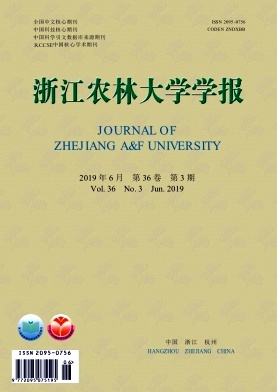-
美国流苏Chionanthus virginicus为木犀科Oleaceae流苏树属Chionanthus的落叶灌木或小乔木,原产美国东南部[1]。美国流苏的花、叶都具有较高的观赏价值,开花时节,满树白花似雪,花香四溢,清新淡雅,秋天树叶金黄,另有一番景致,可应用于庭院、公园、水边和道路绿化等[1-2]。美国流苏还具有较高的药用价值,其茎和根皮中含有木脂素和环烯醚萜苷等抗氧化物质,可以作为食品、药品和护肤品的天然植物原料开发利用[3-4]。因此,美国流苏具有引种推广的潜力以及巨大的应用前景。美国流苏主要为播种繁殖,种子由坚硬的外壳包裹,具有休眠特性[5],不易发芽,且播种苗生长缓慢,给其引种、繁殖和推广带来不便。而扦插繁殖有利于实现美国流苏等难发芽树种的大规模生产及推广。目前,美国流苏在国内还未得到应用和推广,相关报道较少,仅在种子、容器育苗和组培方面有所涉及[2, 6-7],在扦插繁殖方面未见报道。进行美国流苏扦插繁殖试验有利于实现其规模化繁殖和推广应用。选用适宜的扦插基质和植物生长调节剂组合可以显著提升插穗的生根效果[8-9],而可溶性糖、淀粉和可溶性蛋白质作为插穗内部的主要营养物质,其含量变化与插穗生根关系密切[10],直接影响到插穗的生根指标,反映各处理的扦插生根效果。因此,本研究从基质、植物生长调节剂等方面优化美国流苏硬枝扦插繁殖技术,并通过测定分析插穗生根过程中体内营养物质质量分数的变化,探索其扦插生根过程中的生理变化,以期为美国流苏扦插繁殖提供理论参考和技术指导。
HTML
-
试验在南京林业大学园林实验教学示范中心温室苗床上进行。
-
试验材料为来自美国2年生的美国流苏实生苗,挑选生长健壮、无病虫害的母株,剪取粗壮枝条,置于水深3~5 cm的桶中进行保湿。剪取插穗长度为8~12 cm,上切口平切,下切口斜切,带6~8个完整饱满芽,并保留2片1/2叶。20支扎成一捆,用体积分数为0.3%的多菌灵溶液消毒,清水洗净后于水中浸泡备用。
-
扦插开始于2017年3月18日,各处理3次重复,各重复50根插穗。基质种类试验:采用单因素随机区组试验,插穗用吲哚丁酸(IBA)500 mg·L-1浸泡60 min后,扦插于6种不同的基质中:①珍珠岩,②草炭,③河沙,④V(珍珠岩):V(蛭石)=7:3,⑤V(珍珠岩):V(草炭)=7:3,⑥V(珍珠岩):V(园土)=7:3等。植物生长调节剂试验:采用植物生长调节剂种类(A)、质量浓度(B)、处理时间(C)进行L9(34)正交试验,具体因素和水平见表 1。扦插基质为V(珍珠岩):V(蛭石)=7:3。插穗内部营养物质测定试验:以V(珍珠岩):V(蛭石)=7:3为基质,500 mg·L-1 IBA浸泡插穗60 min,以清水处理作为对照(ck),进行单因素试验,各处理3次重复,每重复50根插穗。
水平 种类(A) ρ(B)/(mg·L-1) t(C)/min 1 吲哚乙酸(IAA) 100 1/6(10 s) 2 吲哚丁酸(IBA) 500 30 3 萘乙酸(NAA) 1 000 60 Table 1. Factors and levels of orthogonal test
-
扦插前将基质进行消毒,扦插密度为10 cm × 10 cm,深度为插穗的1/2,压实四周,插好标牌,立即浇透水。通过自动喷雾系统和手动浇水相结合方式,控制空气和基质的湿度,并定期喷施多菌灵消毒液,腐烂和感染病菌的插穗立即拔出。
-
形态指标测定:扦插70 d后测量并统计相关的生根指标,包括愈伤率、生根率、平均不定根数、最长不定根长、最长不定根粗、根系效果指数[11](平均根长×根系数量/总插穗数)。营养物质测定:采样时间为扦插当天起,隔12 d,各处理共取样6次,6根·次-1,3次重复。洗净后,小刀刮取插穗基部(下切口往上3 cm)的韧皮部,蒽酮比色法测定可溶性糖和淀粉质量分数,考马斯亮蓝G-250法测定可溶性蛋白质质量分数[12]。
1.1. 试验地点
1.2. 试验材料
1.3. 试验设计
1.4. 扦插管理
1.5. 形态指标和营养物质测定
-
受不同基质的影响,插穗生根率、愈伤率、平均不定根数、根系效果指数达极显著差异(P<0.01),最长不定根长、最长不定根粗达显著差异(P<0.05)。从表 2可知:处理④的生根率、根系效果指数和愈伤率最高,分别为43.33%,7.64和60.00%,其他生根指标均达最佳水平,可见具有良好的保水、保温及透气性的混合基质生根效果较好;处理⑤的生根率达36.67%,平均不定根数为6.01条,各生根性状与处理④无显著差异;处理②的生根率和愈伤率显著下降,但最长不定根长和最长不定根粗最佳,分别为6.88 cm和0.75 mm,根系效果指数仅次于处理④,说明草炭利于不定根的伸长生长;处理①的生根率与处理②无显著差异,但根系效果指数下降显著,为1.69,可能由于珍珠岩缺乏营养、保水性不强而影响不定根生长;处理③的生根率最差,为8.33%,与处理⑥差异不显著,极显著低于其他处理,根系效果指数最低,为0.43,也显著低于其他处理,可能与园土、河沙易板结有关。综上所述,最佳的扦插基质为V(珍珠岩):V(蛭石)=7:3,河沙的扦插生根效果最差。
处理 基质种类 生根率/% 愈伤率/% 平均不定根数/条 最长不定根长/cm 最长不定根粗/mm 根系效果指数 ① 珍珠岩 28.33 Bc 53.33 Aab 3.02 CDcd 4.07 Bc 0.52 ABbc 1.69 Bbc ② 草炭 33.33 ABbc 45.00 Ab 5.76 Aa 6.88 Aa 0.75 Aa 7.22 Aa ③ 河沙 8.33 Cd 28.33 Bc 2.17 Dd 5.11 ABbc 0.45 Bc 0.43 Bc ④ V(珍珠岩):V(蛭石)=7:3 43.33 Aa 60.00 Aa 4.90 ABab 6.23 ABab 0.71 Aa 7.64 Aa ⑤ V(珍珠岩):V(草炭)=7:3 36.67 ABab 50.00 Aab 6.01 Aa 6.55 Aab 0.64 ABab 6.53 Aa ⑥ V(珍珠岩):V(园土)=7:3 10.00 Cd 16.67 Bd 3.97 BCbc 4.47 ABc 0.62 ABabc 2.41 Bb 说明:同列不同大、小写字母分别表示处理间在0.01和0.05水平下差异显著 Table 2. Rooting situation of hardwood cutting on different mediums of Chionanthus virginicus
-
方差分析表明:各植物生长调节剂处理组合间生根率、根系效果指数达极显著差异。从表 3可知:处理⑤(IBA 500 mg·L-1浸泡60 min)的生根率和根系效果指数最高,分别为43.33%和6.65;处理①(100 mg·L-1 IAA速蘸插穗基部10 s)的生根率和根系效果指数最低,分别为11.67%和0.22。
处理号 种类(A) ρ (B) t(c) 生根率/% 根系效果指数 ① 1 1 1 11.67 Ef 0.22 Ef ② 1 2 2 28.33 BCbcd 3.05 Cc ③ 1 3 3 21.67 CDde 1.08 DEef ④ 2 1 2 33.33 Bb 4.53 Bb ⑤ 2 2 3 43.33 Aa 6.65 Aa ⑥ 2 3 1 30.00 BCbc 1.81 CDde ⑦ 3 1 3 23.33 CDcde 2.41 Ccd ⑧ 3 2 1 18.33 DEe 0.49 Ef ⑨ 3 3 2 25.00 BCDcde 2.52 Ccd 说明: 1,2, 3分别表示表 1的水平。同列不同大、小写字母分别表示处理间在0.01和0.05水平下差异显著 Table 3. Rooting situation of hardwood cutting with different plant growth regulators of Chionanthus virginicus
表 4和表 5多重比较可知:IBA处理的生根效果最佳,生根率和根系效果指数分别为35.56%和4.33,极显著优于NAA和IAA;质量浓度为500 mg·L-1时生根率和根系效果指数最高,分别为30.00%和3.39,显著高于1 000和100 mg·L-1的处理;植物生长调节剂处理的时间越长,插穗生根效果越好,30和60 min处理间的差异不显著,但浸泡60 min生根率和根系效果指数略高。因此,最佳生根率组合为500 mg·L-1的IBA浸泡60 min,500 mg·L-1的IBA浸泡30 min次之。
水平 种类(A) ρ (B) t(C) K1 20.56 Bb 22.78 Bb 20.00 Bb K2 35.56 Aa 30.00 Aa 28.89 Aa K3 22.22 Bb 25.56 ABb 29.44 Aa R 15.00 7.22 9.44 说明:同列不同大、小写字母分别表示在0.01和0.05水平下差异显著。K为各因素对应水平下的平均生根率,R为K的极差值 Table 4. Effects of different plant growth regulators on rooting rate of hardwood cuttings of Chionanthus virginicus
水平 种类(A) ρ (B) t(C) k1 1.45 Bb 2.39 Bb 0.84 Bb k2 4.33 Aa 3.39 Aa 3.36 Aa k3 1.80 Bb 1.80 Bb 3.38 Aa r 2.88 1.59 2.54 说明:同列不同大、小写字母分别表示在0.01和0.05水平下差异显著。k为各因素对应水平下的平均根系效果指数,r为k的极差值 Table 5. Effects of different plant growth regulators on the root effect index of hardwood cuttings of Chionanthus virginicus
由表 4和表 5中R和r值可知:各因素对插穗生根率、根系效果指数影响程度的从大到小依次为生长调节剂种类、处理时间、质量浓度。因此,植物生长调节剂种类的选择最为重要,其次为处理时间。
-
如图 1A所示:春季硬枝扦插生根过程中,对照(ck)插穗的可溶性糖质量分数变化趋势为下降—上升,IBA处理插穗呈下降—上升—下降的趋势。扦插前中期,可溶性糖质量分数一直降低,可能插穗被剪切后,基部受到机械损伤,呼吸效率提升,增强了体内的代谢活动,加大可溶性糖的消耗;之后插穗开始诱导产生愈伤组织,细胞代谢活跃,加上叶芽的萌发、生长,再次加大营养的消耗,导致可溶性糖质量分数持续下降;到第36天,处理插穗的可溶性糖质量分数降到最低值,为25.40 mg·g-1,而对照插穗在第48天达谷值,为26.03 mg·g-1。第48~60天,对照插穗可溶性糖质量分数有所上升,此时新叶大量展开,能够进行光合作用,合成产物向下运输,部分用于不定根生长,部分在基部积累。IBA处理后插穗的可溶性糖质量分数比对照提前上升,其不定根也较早出现,说明IBA加快了生根进程。最后由于不定根的伸长生长,处理插穗可溶性糖质量分数再次下降。
-
由图 1B可知:IBA处理插穗淀粉质量分数的变化趋势为下降—上升,对照插穗则为下降—上升—下降。扦插开始后,淀粉质量分数处于持续下降的趋势,到第36天,处理和对照插穗的淀粉质量分数都达到谷值,分别为37.92和26.95 mg·g-1。由于插穗基部愈伤组织的形成、不定根的诱导以及叶芽的萌发等,导致插穗需要水解大量的淀粉来形成糖类等营养物质,以维持插穗的生根进程。0~12 d处理插穗淀粉质量分数下降速度较快,可能是由于IBA的处理加速了淀粉的水解所致。36~60 d,处理插穗的淀粉质量分数处于上升趋势,此时新叶展开,进行光合作用同化产物,并形成不定根以吸收养分,淀粉得以转化储存下来。对照插穗的淀粉质量分数在48~60 d再次下降,可能由于其不定根形成、生长较缓慢,需要消耗淀粉用于不定根的生长,也导致后期营养不足,生根率降低。
-
如图 1C所示,IBA处理插穗的可溶性蛋白质质量分数含量呈下降—上升—下降的趋势,对照插穗呈下降—上升的趋势。起初,可溶性蛋白质质量分数持续下降,第24天时,处理插穗的可溶性蛋白质质量分数降到谷值(6.78 mg·g-1),对照插穗则在第36天达谷值,为6.74 mg·g-1。一系列的生理活动加大了插穗体内能量的消耗,可溶性蛋白质被转化为能量用于插穗生根。同时,此阶段可溶性糖、淀粉质量分数也处于下降趋势,减少了蛋白质的合成原料,导致其合成量减少。24~36 d,IBA处理插穗可溶性蛋白质质量分数呈上升趋势,可能叶片的光合产物以及其他物质的转化,能够满足此时的愈伤组织形成所需,可溶性蛋白质得以储存,为后期不定根的诱导、形成积累了营养物质。对照插穗在第36~60天处于上升趋势,可能由于其生根进展较缓慢,对能量的消耗较少,且新叶的展开为插穗提供了能量,使得体内可溶性蛋白质逐渐增多。
2.1. 基质种类对美国流苏扦插生根的影响
2.2. 植物生长调节剂对美国流苏扦插生根的影响
2.3. 营养物质质量分数的变化
2.3.1. 可溶性糖
2.3.2. 淀粉
2.3.3. 可溶性蛋白质
-
插穗生根环境由基质构成,基质的理化性质对生根极为重要,理想的基质应具有优良的透气、保水性和一定的营养[13]。本研究中,基质种类对美国流苏插穗生根效果影响显著,V(珍珠岩):V(蛭石)=7:3的基质扦插生根效果最好,其生根率、根系效果指数和愈伤率均最高。与青钱柳Cyclocarya paliurus[14],美国红枫Acer rubrum[15]等扦插试验结果一致,可能因为珍珠岩+蛭石具有较好的保温、保湿和透气性。V(珍珠岩):V(草炭)=7:3的基质生根效果次之,可能由于草炭的透气透水性一般,插穗基部易腐烂,但草炭富含有机质,保水能力强,往往能够提升不定根的数量和质量[16]。本研究就单一基质而言,草炭的生根率高于珍珠岩和河沙,珍珠岩的扦插生根效果较差,是由于珍珠岩保水性不强,且缺乏营养。河沙和园土在扦插过程中极易板结,导致扦插效果较差,为不理想的扦插基质。小果核果茶Pyrenaria microcarpa[17]和复叶槭Acer negundo[18]等扦插试验也表明:河沙为最不理想的扦插基质。本研究对比可知:混合基质的扦插生根效果优于单一基质,与细叶水团花Adina rubella[16]和番石榴Psidium guajava[19]的结果一致,说明混合基质能够弥补单一基质的不足,优化其理化性质。可见,依据不同植物进行合理的基质配比,可以提高生根效果。
-
本研究中,植物生长调节剂种类、质量浓度和处理时间对插穗生根率均有显著影响。其中,种类对生根率的影响最大,IBA的扦插效果显著优于NAA和IAA,与希蒙得木Simmondsia chinensis[20],大无花果Ficus roxburghii[21]和流苏树Chionanthus retusus[22]等扦插生根试验结论一致。可能是由于IAA性质较不稳定,容易在光下被氧化或在植物体内被吲哚乙酸氧化酶(IAAO)降解,NAA质量浓度较高易伤害插条,IBA性状稳定,不易被分解[23]。大叶桃花心木Swietenia macrophylla[24]和山木通Clematis finetiana [25]等多数试验均认为IBA促进插穗生根效果突出。质量浓度为500 mg·L-1时生根率显著提升,说明适中的植物生长调节剂质量浓度往往更有利于提升插穗的生根率,质量浓度过低时促根效果不显著,过高时对插穗造成伤害,影响到生根[21, 26]。处理时间为30和60 min时,两者的生根效果差异不显著,但浸泡60 min的生根率略高。本研究的质量浓度较适中,10 s速蘸时间过短,生根效果较差。综上所述,本研究最佳植物生长调节剂组合为500 mg·L-1的IBA浸泡60 min。
-
插穗体内营养物质的水平对插穗的生根能力影响很大[10]。扦插开始后插穗的可溶性糖质量分数一直处于下降趋势,插穗的机械损伤、愈伤组织的形成、新叶的萌发和不定根的形成等,消耗了大量的可溶性糖。此变化趋势与短梗大参Macropanax rosthornii扦插的研究结果一致[27]。此外,相关研究[28]表明:插穗的生根率与可溶性糖质量分数呈正相关关系。因此,扦插生根后期较低的可溶性糖质量分数也是其生根率低的原因之一。在IBA的作用下,插穗淀粉质量分数在前期下降幅度较大,榉树Zelkova schneideriana[29]和裸花紫珠Callicarpa nudiflora[30]等试验同样出现此现象,均认为植物生长调节剂加速了淀粉的水解,产生更多的可溶性糖等物质,加快了插穗生根进程,有利于提升生根率。观察可溶性蛋白质变化曲线可知:植物生长调节剂缩短了生根周期,利于不定根的形成。
-
美国流苏为难生根树种,使用500 mg·L-1的IBA浸泡插穗60 min,扦插于V(珍珠岩):V(蛭石)=7:3的基质中,生根效果最佳,生根率为43.33%。IBA处理加快了营养物质的变化,缩短了生根周期,有利于提升生根率。在实际生产中,美国流苏硬枝可以作为繁殖材料进行充分利用,以扩大繁殖规模。








 DownLoad:
DownLoad: